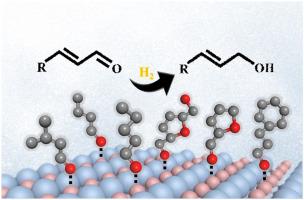Applied Catalysis B: Environment and Energy ( IF 20.2 ) Pub Date : 2020-06-25 , DOI: 10.1016/j.apcatb.2020.119273 Jun Yu , Yusen Yang , Lifang Chen , Zhenhua Li , Wei Liu , Enze Xu , Yuanjing Zhang , Song Hong , Xin Zhang , Min Wei

|
Intermetallic compounds (IMCs) have evoked considerable attention as high-selectivity catalysts in chemical processes by virtue of their exceptional structural properties. Here we report a general method to obtain Ni-based IMCs via structural transformation from layered double hydroxides (LDHs) precursor, which exhibit excellent selectivity toward CO hydrogenation in various unsaturated aldehydes (crotonaldehyde, 3-methyl-2-butenal, 2-pentenal, furfural, 5-hydroxymethylfurfural and cinnamaldehyde). The optimal catalyst (NiBi IMCs) displays surprisingly high selectivity toward unsaturated alcohols (97.2%, 93.2%, 94.5%, 97.7%, 97.9% and 98.9%, respectively). A combination investigation based on STEM, XANES, and in situ CO
IR verifies a rugged and ordered surface atomic structure, due to the huge difference in atomic radius between Ni and Bi. Both experiment characterization (in situ FT-IR) and theory calculation (DFT) reveal that the well-organized surface atomic arrangement with a steric hindering effect gives rise to the vertical adsorption configuration of unsaturated aldehydes, resulting in selective hydrogenation of C
O instead of C
C group. This work shows a significant paradigm for investigation of LDHs-based IMCs catalyst via a deep viewpoint on structure-selectivity relationship, which is potentially applied as a hopeful candidate in heterogeneous hydrogenation catalysis.
中文翻译:

NiBi金属间化合物催化不饱和醛选择性加氢
金属间化合物(IMC)凭借其出色的结构性能而在化学过程中作为高选择性催化剂引起了广泛关注。在这里,我们报告了一种通过从层状双氢氧化物(LDHs)前体进行结构转变获得Ni基IMC的一般方法,该方法在各种不饱和醛(巴豆醛,3-甲基-2-丁烯醛,2-戊烯醛)中对CO加氢表现出优异的选择性,糠醛,5-羟甲基糠醛和肉桂醛)。最佳催化剂(NiBi IMCs)对不饱和醇表现出惊人的高选择性(分别为97.2%,93.2%,94.5%,97.7%,97.9%和98.9%)。基于STEM,XANES和原位CO的组合调查
由于Ni和Bi之间的原子半径存在巨大差异,IR证实了崎and有序的表面原子结构。实验表征(原位FT-IR)和理论计算(DFT)均表明,具有空间位阻作用的组织良好的表面原子排列会引起不饱和醛的垂直吸附构型,从而导致C
O的选择性加氢而不是C
C组。这项工作通过对结构-选择性关系的深入研究,为研究基于LDHs的IMCs催化剂显示了重要的范例,它有可能作为多相加氢催化的有希望的候选者。











































 京公网安备 11010802027423号
京公网安备 11010802027423号